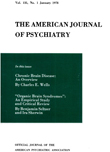ELECTROENCEPHALOGRAM IN POSTENCEPHALITIC BEHAVIOR DISORDER AND POSTENCEPHALITIC PARKINSONISM
Abstract
In a review of the electroencephalographic findings in patients with postencephalitic behavior disorder and postencephalitic parkinsonism, the following observations were made:
1. Of 15 cases with postencephalitic behavior disorder, 13 (87%) showed some electroencephalographic abnormalities, most of which were of a mild degree and of the slow wave type. There were 3 cases with a history of convulsive seizures as an added complication of the encephalitis. In 2 of these the tracings were markedly abnormal. These findings are consistent with the observations of others that in the behavior disorders associated with organic brain disease there is a relatively high incidence of electroencephalographic abnormality.
2. In a series of 36 cases with postencephalitic Parkinsonism, 11 (31%) showed some electroencephalographic abnormalities, which were all of mild degree and primarily of the slow wave type, although a moderate amount of fast activity was also observed.
Access content
To read the fulltext, please use one of the options below to sign in or purchase access.- Personal login
- Institutional Login
- Sign in via OpenAthens
- Register for access
-
Please login/register if you wish to pair your device and check access availability.
Not a subscriber?
PsychiatryOnline subscription options offer access to the DSM-5 library, books, journals, CME, and patient resources. This all-in-one virtual library provides psychiatrists and mental health professionals with key resources for diagnosis, treatment, research, and professional development.
Need more help? PsychiatryOnline Customer Service may be reached by emailing [email protected] or by calling 800-368-5777 (in the U.S.) or 703-907-7322 (outside the U.S.).



